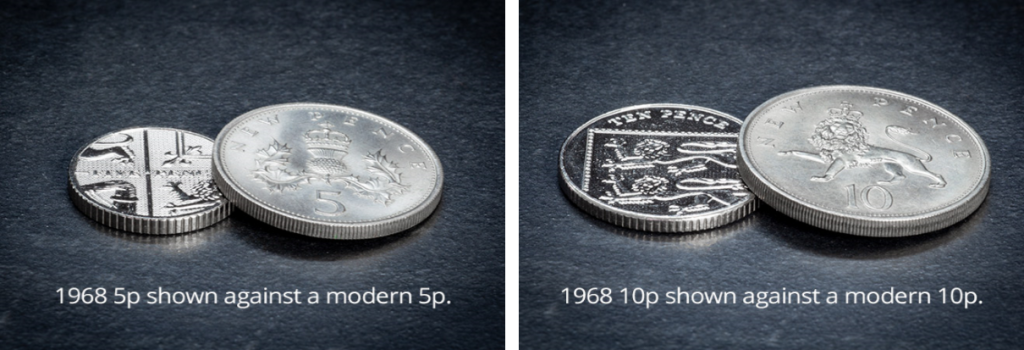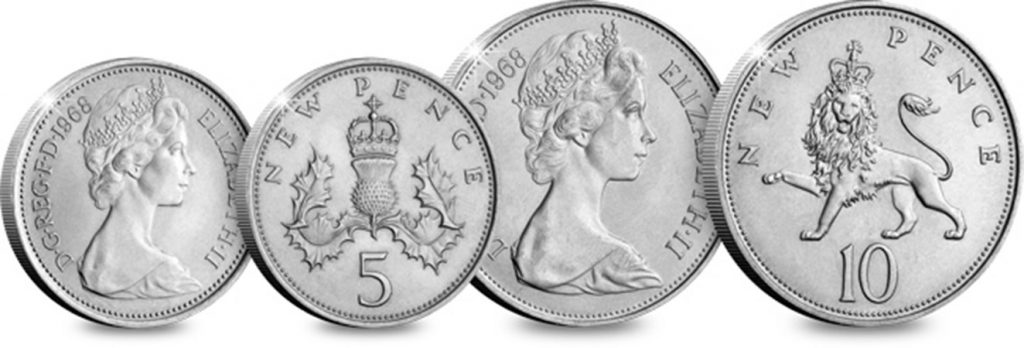Posts Tagged ‘conversion’
50 years since the most important moment in British numismatic history…
2018 marks the 50th anniversary of arguably the most important moment in British numismatic history – the first coins issued for decimalisation.
In 1968, the British public would have found 5p and 10p coins in their change for the very first time, issued as part of Britain’s conversion to a system of decimal currency.

1968 5p and 10p coins
The coins bore new heraldic designs, but were exactly the same size and value as shillings and florins, which meant the changeover process should have been a smooth transition. However, after generations of pounds, shillings and pence, the Decimal Currency Board still needed to reassure suspicious Britons to go decimal – a case which had actually been argued as long ago as 1696 by Sir Christopher Wren.

Advert from the Decimal Currency Board. Credit: Daily Mail
It was the 1960 report by the Association of British Chambers of Commerce and the British Association for the Advancement of Science which finally set into action a currency based upon simple multiples, a system already adopted by a number of Commonwealth countries including Australia, New Zealand and South Africa.
A massive number of coins were required for the changeover, forcing The Royal Mint to move location from Tower Hill to its new production facility in Llantrisant, South Wales, where the first of almost six billion coins required for decimalisation went into production.

The Royal Mint at Tower Hill, London. Credit: The Royal Mint museum
It was then on the 23rd April 1968 that the new 5p and 10p coins went into circulation, operating as legal tender up to the sum of £5, with mintage figures of 98,868,250 and 336,143,250 respectively.
The humble 5p featured the Christopher Ironside reverse design until 2008 and has since featured Matthew Dent’s reverse design, following a public competition held by The Royal Mint. On the 27th June 1990, a reduced size version of the coin was introduced and the older, larger coins were withdrawn on the 31st December 1990, although the design remained unchanged.
Similarly, the 10p coin also featured Christopher Ironside’s reverse design up until 2008 when this was replaced by Matthew Dent’s. However, the 10p remained a larger coin until the 30th September 1992, when the reduced size version was introduced, with the larger coin being removed from circulation a year later.

As we seem to move ever closer towards a cashless society, the questions lingers as to how long these decimalised coins will remain a necessity… However, this year’s release of 26 brand new A-Z of Great Britain 10p coin designs just goes to show that the demand for the smaller denomination coins is still there. In fact, these little coins have become incredibly sought-after and have dominated news stories and conversations amongst collectors, with everyone wanting to get their hands on the elusive coins!
Although the nation seemed reluctant to accept these decimal coins back in 1968, I think it’s fair to say that they have now become a much loved part of British coinage and as we celebrate the 50th anniversary of the first decimalised coins, we can look back with fondness for the 5p and 10p coins.
Own the very first coins issued for decimalisation!
The First Decimalised Coins include the original 5p and 10p coins from their first year of issue, 1968.
Order yours today to mark the 50th anniversary of the introduction of these significant coins >>

